- Home
- Ramachandra Guha
India After Gandhi: The History of the World's Largest Democracy
India After Gandhi: The History of the World's Largest Democracy Read online
RAMACHANDRA GUHA
INDIA
AFTER GANDHI
The History of the
World’s Largest Democracy
PAN BOOKS
For
Ira, Sasha and Suja:
lights on my coast
India is a pluralist society that creates magic with democracy, rule of law and individual freedom, community relations and [cultural] diversity. What a place to be an intellectual! . . . I wouldn’t mind being born ten times to rediscover India.
ROBERT BLACKWILL, departing US ambassador, in 2003
Nobody could be more conscious than I am of the pitfalls which lie in the path of the man who wants to discover the truth about contemporary India.
NIRAD CHAUDHURI,
The Autobiography of an Unknown Indian (1950)
Contents
Prologue: Unnatural Nation
PART ONE – PICKING UP THE PIECES
1. Freedom and Parricide
2. The Logic of Division
3. Apples in the Basket
4. A Valley Bloody and Beautiful
5. Refugees and the Republic
6. Ideas of India
PART TWO – NEHRU’S I NDIA
7. The Biggest Gamble in History
8. Home and the World
9. Redrawing the Map
10. The Conquest of Nature
11. The Law and the Prophets
12. Securing Kashmir
13. Tribal Trouble
PART THREE – SHAKING THE CENTRE
14. The Southern Challenge
15. The Experience of Defeat
16. Peace in Our Time
17. Minding the Minorities
PART FOUR – THE RISE OF POPULISM
18. War and Succession
19. Leftward Turns
20. The Elixir of Victory
21. The Rivals
22. Autumn of the Matriarch
23. Life Without the Congress
24. Democracy in Disarray
25. This Son also Rises
PART FIVE – A HISTORY OF EVENTS
26. Rights
27. Riots
28. Rulers
29. Riches
30. A People’s Entertainments
Epilogue: Why India Survives
Acknowledgements
Notes
Index
Prologue
* * *
Unnatural Nation
I
Because they are so many, and so various, the people of India are also divided. It appears to have always been so. In the spring of 1827 the poet Mirza Asadullah Khan Ghalib set out on a journey from Delhi to Calcutta. Six months later he reached the holy Hindu city of Banaras. Here he wrote a poem called ‘Chirag-i-Dair’ (Temple Lamps), which contains these timeless lines:
Said I one night to a pristine seer
(Who knew the secrets of whirling Time),
‘Sir, you well perceive,
That goodness and faith,
Fidelity and love
Have all departed from this sorry land.
Father and son are at each other’s throat;
Brother fights brother. Unity
and Federation are undermined.
Despite these ominous signs
Why has not Doomsday come?
Why does not the Last Trumpet sound?
Who holds the reins of the Final Catastrophe?’1
Ghalib’s poem was composed against the backdrop of the decline of the Mughal Empire. His home territory, the Indo-Gangetic plain, once ruled by a single monarch, was now split between contending chiefdoms and armies. Brother was fighting brother; unity and federation were being undermined. But even as he wrote, a new (and foreign) power was asserting its influence across the land in the form of the British, who were steadily acquiring control of the greater part of the subcontinent. Then in 1857 large sections of the native population rose up in what the colonialists called the Sepoy Mutiny and Indian nationalists later referred to as the First War of Indian Independence.
Some of the bloodiest fighting was in Ghalib’s home town, Delhi – still nominally the capital of the Mughals and in time to become the capital of the British Raj as well. His own sympathies were divided. He was the recipient of a stipend from the new rulers, yet a product of Mughal culture and refinement. He saw, more clearly than the British colonialist did then or the Indian nationalist does now, that it was impossible here to separate right from wrong, that horrible atrocities were being committed by both sides. Marooned in his home, he wrote a melancholy account of how ‘Hindustan has become the arena of the mighty whirlwind and the blazing fire’. ‘To what new order can the Indian look with joy?’ he asked.2
An answer to this question was forthcoming. After the events of 1857 the Crown took over control of the Indian colonies. A sophisticated bureaucracy replaced the somewhat ad-hoc and haphazard administration of the old East India Company. New districts and provinces were created. The running of the state was overseen by the elite cadre of the Indian Civil Service supported by departments of police, forests, irrigation, etc. Much energy (and money) was spent on building a railway network that criss-crossed the land. This contributed enormously to the unity of British India, as well as to its stability, for now the rulers could quickly move troops to forestall any repeat of 1857.
II
By 1888 the British were so solidly established in India that they could anticipate, if not a thousand-year Raj, at least a rule that extended well beyond their own lifetimes. In that year a man who had helped put the Raj in place gave a series of lectures in Cambridge which were later published in book form under the simple title India. The man was Sir John Strachey. Strachey had spent many years in the subcontinent, ultimately becoming amember of the Governor General’s Council. Now in retirement in England, he set his Indian experience against the background of recent political developments in Europe.
Large chunks of Strachey’s book are taken up by an administrative history of the Raj; of its army and civil services, its land and taxation policies, the peculiar position of the ‘native states’.This was a primer for those who might work in India after coming down from Cambridge. But there was also a larger theoretical argument to the effect that ‘India’ was merely alabel of convenience, ‘a name which we give to a great region including a multitude of different countries’.
In Strachey’s view, the differences between the countries of Europe were much smaller than those between the ‘countries’ of India. ‘Scotland is more like Spain than Bengal is like the Punjab.’ In India the diversities of race, language and religion were far greater. Unlike in Europe, these ‘countries’ were not nations; they did not have a distinct political or social identity. This, Strachey told his Cambridge audience, ‘is the first and most essential thing to learn about India – that there is not, and never was an India, or even any country of India possessing, according to any European ideas, any sort of unity, physical, political, social or religious’.
There was no Indian nation or country in the past; nor would there be one in the future. Strachey thought it ‘conceivable that national sympathies may arise in particular Indian countries’, but ‘that they should ever extend to India generally, that men of the Punjab, Bengal, the North-western Provinces, and Madras, should ever feel that they belong to one Indian nation, is impossible. You might with as much reason and probability look forward to a time when a single nation will have taken the place of the various nations of Europe.’3
Strachey’s remarks were intended as a historical judgement. At the time, new nations w
ere vigorously identifying themselves within Europe on the basis of a shared language or territory, whereas none of the countries that he knew in India had displayed a comparable national awakening. But we might also read them as a political exhortation, intended to stiffen the will of those in his audience who would end up in the service of the Raj. For the rise of every new ‘nation’ in India would mean a corresponding diminution in the power and prestige of Empire.
Ironically, even as he spoke Strachey’s verdict was being disputed by a group of Indians. These had set up the Indian National Congress, a representative body that asked for a greater say for natives in the running of their affairs. As the name suggests, this body wished to unite Indians across the divisions of culture, territory, religion, and language, thus to construct what the colonialist thought inconceivable – namely, a single Indian nation.
Very many good books have been written on the growth of the Indian National Congress, on its move from debating club through mass movement to political party, on the part played by leaders such as Gokhale, Tilak and (above all) Gandhi in this progression. Attention has been paid to the building of bridges between linguistic communities, religious groupings and castes. These attempts were not wholly successful, for low castes and especially Muslims were never completely convinced of the Congress’s claims to be a truly ‘national’ party. Thus it was that when political independence finally came in 1947 it came not to one nation, but two – India and Pakistan.
This is not the place to rehearse the history of Indian nationalism.4 I need only note that from the time the Congress was formed right up to when India was made free – and divided – there were sceptics who thought that Indian nationalism was not a natural phenomenon at all. There were, of course, British politicians and thinkers who welcomed Indian self-rule and, in their own way, aided its coming into being. (One of the prime movers of the Indian National Congress was a colonial official of Scottish parentage, A. O. Hume.) Yetthere were many others who argued that, unlike France or Germany or Italy, there was here no national essence, no glue to bind the people and take them purposively forward. From this perspective stemmed the claim that it was only British rule that held India and the Indians together.
Among those who endorsed John Strachey’s view that there could never be an independent Indian nation were writers both famous and obscure. Prominent in the first category was Rudyard Kipling, who had spen this formative years in – and was to write some of his finest stories about – the subcontinent. In November 1891 Kipling visited Australia, where a journalist asked him about the ‘possibility of self-government in India’. ‘Oh no!’ he answered: ‘They are 4,000 years old out there, much too old to learn that business. Law and order is what they want and we are there to give it to them and we give it them straight.’5
Where Kipling laid emphasis on the antiquity of the Indian civilization, other colonialists stressed the immaturity of the Indian mind to reach the same conclusion: namely, that Indians could not govern themselves. A cricketer and tea planter insisted, after forty years there, that
[c]haos would prevail in India if we were ever so foolish to leave the natives to run their own show. Ye gods! What a salad of confusion, of bungle, of mismanagement, and far worse, would be the instant result.
These grand people will go anywhere and do anything if led by us.
Themselves they are still infants as regards governing or statesmanship. And their so-called leaders are the worst of the lot.6
Views such as these were widely prevalent among the British in India, and among the British at home as well. Politically speaking, the most important of these ‘Stracheyans’ was undoubtedly Winston Churchill. In the 1940s, with Indian independence manifestly round the corner, Churchill grumbled that he had not become the King’s first minister in order to preside over the liquidation of the British Empire.
A decade previously he had tried to rebuild a fading political career on the plank of opposing self-government for Indians. After Gandhi’s ‘salt satyagrafra’ of 1930 in protest against taxes on salt, the British government began speaking with Indian nationalists about the possibility of granting the colony dominion status. This was vaguely defined, with no timetable set for its realization. Even so, Churchill called the idea ‘not only fantastic in itself but criminally mischievous in its effects’. Since Indians were not fit for self-government, it was necessary to marshal ‘the sober and resolute forces of the British Empire’ to stall any such possibility.
In 1930 and 1931 Churchill delivered numerous speeches designed to work up, in most unsober form, the constituency opposed to independence for India. Speaking to an audience at the City of London in December 1930, he claimed that if the British left the subcontinent, then ‘an army of white janissaries, officered if necessary from Germany, will be hired to secure the armed ascendancy of the Hindu’. Three months later, speaking at the Albert Hall on ‘Our Duty to India’ – with his kinsman the Duke of Marlborough presiding – Churchill argued that ‘to abandon India to the rule of the Brahmins [who in his opinion dominated the Congress Party] would be an act of cruel and wicked negligence’. If the British left, he predicted, then the entire gamut of public services created by them – the judicial, medical, railway and public works departments – would perish, and ‘India will fall back quite rapidly through the centuries into the barbarism and privations of the Middle Ages’.7
III
A decade and a half after Winston Churchill issued these warnings, the British left India. A time of barbarism and privation did ensue, the blame for which remains a matter of much dispute. But then some sort of order was restored. No Germans were necessary to keep the peace. Hindu ascendancy, such as it was, was maintained not by force of arms but through regular elections based on universal adult franchise.
Yet, throughout the sixty years since India became independent, there has been speculation about how long it would stay united, or maintain the institutions and processes of democracy. With every death of a prime minister has been predicted the replacement of democracy by military rule; after every failure of the monsoon there has been anticipated country wide famine; in every new secessionist movement has been seen the disappearance of India as a single entity.
Among these doomsayers there have been many Western writers who, after 1947, were as likely to be American as British. Notably, India’s existence has been a puzzle not just to casual observers or commonsensical journalists; it has also been an anomaly for academic political science, according to whose axioms cultural heterogeneity and poverty do not make a nation, still less a democratic one. That India ‘could sustain democratic institutions seems, on the face of it, highly improbable’, wrote the distinguished political scientist Robert Dahl, adding: ‘It lacks all the favourable conditions.’ ‘India has a well-established reputation for violating social scientific generalizations’, wrote another American scholar, adding: ‘Nonetheless, the findings of this article furnish grounds for skepticism regarding the viability of democracy in India.’8
The pages of this book are peppered with forecasts of India’s imminent dissolution, or of its descent into anarchy or authoritarian rule. Here, let me quote only a prediction by a sympathetic visitor, the British journalist Don Taylor. Writing in 1969, by which time India had stayed united for two decades and gone through four general elections, Taylor yet thought that
the key question remains: can India remain in one piece – or will it fragment? . . . When one looks at this vast country and its 524 million people, the 15 major languages in use, the conflicting religions, the many races, it seems incredible that one nation could ever emerge.
It is difficult to even encompass this country in the mind – the great Himalaya, the wide Indo-Gangetic plain burnt by the sun and savaged by the fierce monsoon rains, the green flooded delta of the east, the great cities like Calcutta, Bombay and Madras. It does not, often, seem like one country. And yet there is a resilience about India which seems an assurance of survival. There is somet
hing which can only be described as an Indian spirit.
I believe it no exaggeration to say that the fate of Asia hangs on its survival.9
The heart hoped that India would survive, but the head worried that it wouldn’t. The place was too complicated, too confusing – a nation, one might say, that was unnatural.
In truth, ever since the country was formed there have also been many Indians who have seen the survival of India as being on the line, some (the patriots) speaking or writing in fear, others (the secessionists or revolutionaries) with anticipation. Like their foreign counterparts, they have come to believe that this place is far too diverse to persist as a nation, and much too poor to endure as a democracy.
IV
In the last decade of the last century I became a resident of Ghalib’s native city. I lived, however, not in the old walled town where his family haveli, or mansion, still stands, but in New Delhi, built as an imperial capital by the British. As in the poet’s day, Indian was fighting Indian. On my way to work I had to pass through Rajpath (formerly Kingsway), the road whose name and location signal the exercise of state power. For about a mile, Rajpath runs along flat land; on either side are spacious grounds meant to accommodate the thousands of spectators who come for the annual Republic Day parade. The road then ascends a hill and reaches the majestic sandstone buildings known as the North and South Blocks, which house the offices of the Government of India. The road ends in the great house where the Viceroy of British India once lived.

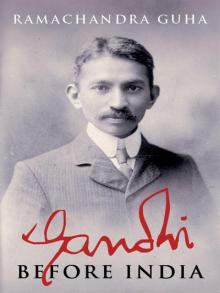 Gandhi Before India
Gandhi Before India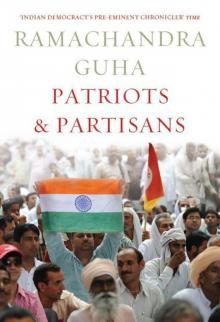 Patriots & Partisans
Patriots & Partisans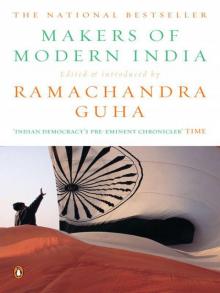 Makers of Modern India
Makers of Modern India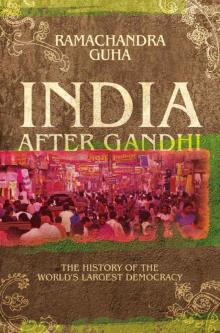 India After Gandhi: The History of the World's Largest Democracy
India After Gandhi: The History of the World's Largest Democracy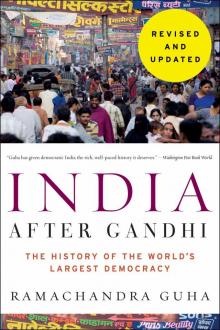 India After Gandhi Revised and Updated Edition
India After Gandhi Revised and Updated Edition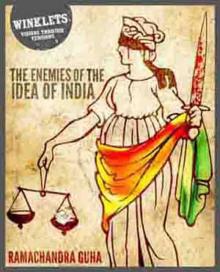 The Enemies of the Idea of India
The Enemies of the Idea of India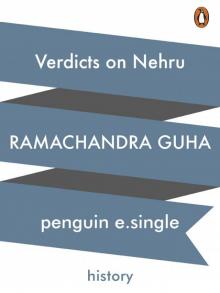 Verdicts on Nehru
Verdicts on Nehru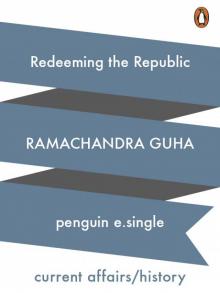 Redeeming the Republic
Redeeming the Republic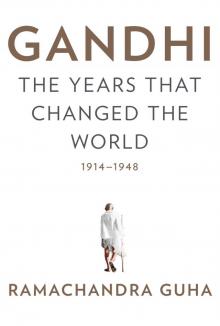 Gandhi
Gandhi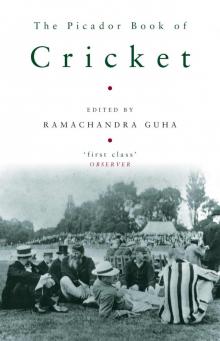 The Picador Book of Cricket
The Picador Book of Cricket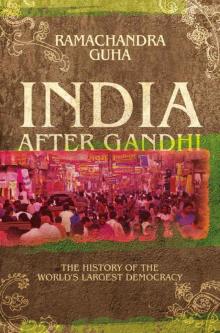 India After Gandhi
India After Gandhi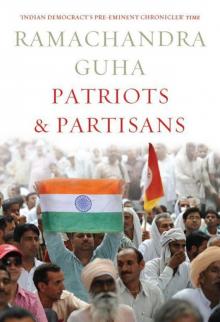 Patriots and Partisans: From Nehru to Hindutva and Beyond
Patriots and Partisans: From Nehru to Hindutva and Beyond